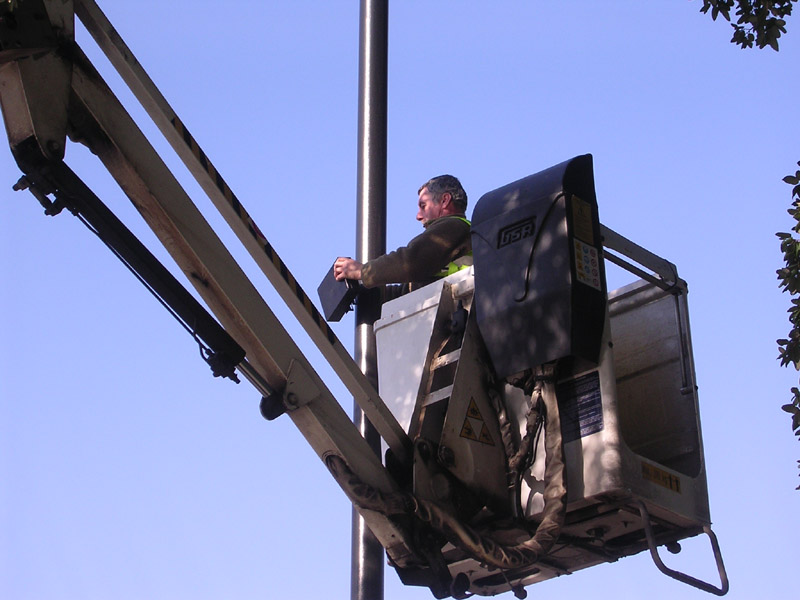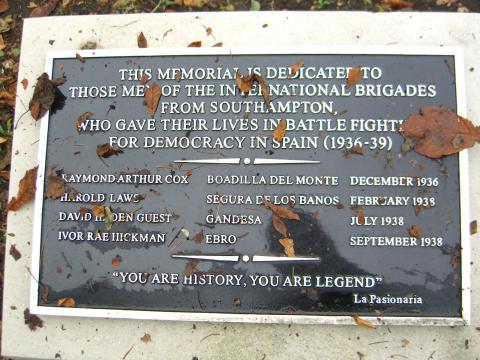Years of research and development will come to a hopefully successfull climax on Friday March 14th with the launch of the Hidden Histories project in Southampton. The project is the result of a collaboration between Armin Medosch and the London based technology development group Hive Networks led by artist-engineer Alexei Blinov. By narrowcasting excerpts from Southampton's Oral History Unit on 10 listening stations in the city centre, we have created a new public interface for negotiating the past (and maybe future) of the city. The article starts with an excerpt from the press release followed by research notes.
Introduction and Overview

The revolutionary concept is tentatively called street radio. The system uses wireless communication technologies such as Wifi and Bluetooth in combination with FM radio to create listening stations where stories from Southampton's Oral History Archive are broadcast through a low range FM radio signal. 10 such listening stations or nodes are currently in the process of being installed in and around the proposed on Above Bar Street and the Civic Centre complex. The nodes, from where bytesized stories are transmitted, link together to form an oral history trail that transports people through the changing life of the city.
Southampton was and is one of Britain's most important ports, a gateway to the world for goods and people coming in and out. But while the commercial significance of the port is undiminished, containerisation and other technological improvements mean that ever fewer people work in the maritime industries. The vibrancy of the heyday of Southampton as a port city is fading away in the public consciousness. As the city reinvents itself, Hidden Histories brings together latest wireless and open source technology to put cultural heritage back into the heart of the city.
The Oral History Unit is an almost hidden juwel in Southamptons culture and heritage department, highly regarded in the international Oral History expert community. Since more than 20 years the OHU has been recording the life stories told by the people themselves. Through the voices of common people it offers a window back into time: on the "tale end of the Dickensian age" as one interviewee puts it himself, where men had to queue every day for work at a shed at the entrance to the docks, to the hard life on the passenger ships and tug boats, an oral history is told that does not conform to the cliches and stereotypes of the official versions produced by todays media industry. The unsung heroes of historical moments such as the sinking of the Titanic or famous journeys of ships such as the Queen Mary are telling their own stories from the insiders perspective. Lesser known stories such as the secret social life on ships, the achievements of women in the heavy industries during WWII, and the troubles of immigrants from Asia and the Caribbean surface in this archive. While many of these stories tell of hardships, they also shine with humanity and joyful moments. (The Plimsoll archive offers quite a few sound examples)
Street Radio brings the best moments of this archive right into the centre of the city and makes it availble to passers by and flaneurs on its streets and parks around the Civic Centre. Audio exerpt: Node 1 The sinking of the Titanic
The project will be launched on Friday 14th of March. Meeting point is the Fountain's Cafe at the Gallery in the Civic Centre from 11 am onwards. FM radio units will be made available for lending. Project website: http://www.hiddenhistories.org.uk currently pointing to http://www.solentcentre.org.uk/participation/hiddenhistories
Research Notes
Hive networks have been researching ways in which wireless community networking can be enriched by the content layer. Hive founder Alexei Blinov and his team have been involved in wireless networking since the beginning of the 2000s. Discussions involving also other people such as James Stevens, Adam Burns, and the author of this text have frequently been concerened with making wireless community networks more attractive by making them to become more than just network infrastructures. Preliminary research led to a successful arts council application which allowed a big leap of technology development in 2006 and 2007.
The changing conceptions of Hive Networks saw it at some point as a creative firmware replacement for cheap ASUS wireless harddrives. However, the background was always provided by a philosophical framework of seeking to create some sort of cheap and open source DIY kit for wireless and ubiquituous computing (cf. this article which I wrote in 2005 for the Node.L publication http://theoriebild.ung.at/view/Main/HiveNetworks).

After a developmental phase during which Blinov travelled to meet other creative open source practitioners such as C-Base members C-ven, Sven Ola and Elektra, as well as the OpenWRT crew, dyne:bolic in Amsterdam and a few others, for creative brainstorming and exchange of ideas, Hive Networks meanwhile have come up with the goodies. They have produced a number of Hivewares or self-described 'personalities'. Those are easy to install prepackaged firmwares preconfigured to allow to enhance the functionality of cheap consumer networking devices. Some of the 'personalities' deliver specific media capacities such as audio capture and streaming, others are scouting the net for connectivity and other Hive boxes. Personalities such as the RoboHive can be combined with others to create mixed 'characters'. A panel allows the remote monitoring and maintainance of the hive nodes.
For Southampton, an ASUS WL-500G premium, that run's OpenWrt http://openwrt.org/ RC-5 firmware and BlueJack http://hivenetworks.net/tiki-index.php?page_ref_id=69 personality, is utilized. Each node scans the environment for phones which have bluetooth turned on and sends them an initial message that asks for permission to send a larger message. The second message contains the FM frequency and information about the type of content which can be heard on the respective node. That way people are prompted to stop and listen. The audio content is broadcast via a weak usb-fm transmitter. Such very low powered short range transmitters have become legal recently.
In principle Hive Networks technology could do far more and play all bells and whistles. The decision for a non-interactive format of broadcasting on a radio frequency is actually conservative, but this conservativism is motivated by the drive to reach as many people as possible and keep the tech threshold low. Many types of mobile phone actually include the functionality of an FM radio receiver. Thus, people can listen to HiddenHistories either with a conventional radio or a mobile phone with radio capacity.
The project is a core project of my practice based PhD. My own conceptual involvement with Hive Networks goes back many years. Through previous research, while on a residency at Scan http://scansite.org/ports/, I came across the Oral History Unit. My interest regards the possibilities of a public interface linking media and the city.
In 2003 I have written a book in German language about wireless community networks. After that my main focus has shifted from the pragmatic aspects of netculture to more artistic and utopian notions such as those treated in the text Wireless Utopia and others, which also inspired the making of the Waves exhibition in Riga in 2006. Currently, regarding my PhD research, my interest is still with the emancipatory potentialities of participatory platforms and how interesting types of participation can be facilitated. In particular I am researching links between communities and technological development which is grounded in them and fosters their needs. One of the starting points for my thesis development is that technological development should become more socially embedded. Currently we have a class of innovators and a class of consumers. As technology progresses unguided by ethical needs, only directed by the dictate of capital:-) we are making very bad uses of the increased mastery over the forces of nature. Technological development which is separated from the world is creating technologies which in turn increase social fragmentation and separation.
Themes or issues which I am exploring with Hidden Histories are
- the link between location or place and stories, narrations
- level of acceptance of this project which does something that hasn't been done before
- the effects of the insertion of this additional immaterial layer into the fabric of public space; will perceptions of spaces/places change?
- consequences of initial design decisions such as the low level of interactivity (only through bluetooth) and the favouring of FM radio
At the same time I am also interested in the aural quality of the voices and the insights which the OHU gives for socio-historic research. Those are not so much hidden histories rather than an alltogether different view of history which emanates from those voices.
The Hidden Histories image gallery contains all relevant images. There is also a Google Map with all the nodes more or less precisele positioned where they will be.

